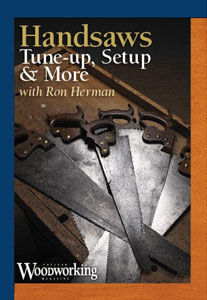
Ron Herman, Hand Saws: Tune-up, Setup & More: DVD Review
by J. Norman Reid
Delaplane, VA
Herman's 70-minute DVD picks up where his first -
Sharpen Your Hand Saws
- leaves off. It assumes you already know how to file and set a saw's teeth and delves into a range of deeper topics. Herman begins by displaying a wide range of saws and briefly discussing their purposes, while correcting some misperceptions about them. He then demonstrates how to select a saw so it fits your hand and arm length, factors that will affect how well you'll be able to use the saw.
A sawyer's bench is an essential tool for a hand tool woodworker. Herman describes how to take the measurements you'll need to size it for your own leg length and saw stroke and gives some helpful construction details. He then addresses the important subject of eye dominance and how to determine it and align your body for accurate sawing.
Some saws seem harder to push comfortably than others, due to differences in the thrust line - the effective angle at which the saw is intended to cut. Choosing saws with the most desirable thrust lines will affect your ease of sawing, as well as the speed with which the saw attacks the cut.
Saws work differently in hard and soft woods, and a saw that cuts well in one may cut poorly in another. Herman shows how to select saws that give the best fast and finish cuts in different wood species. He demonstrates the importance of fleam to the saw's ability to cut well in the situation for which it is intended.
He shows us one of his sawbucks - essentially a storage case in which a range of saws intended for ripping, crosscutting, specialized for various types of wood and different tooth configurations are safely hung for transportation to a job site. He offers enough information to build a similar one of your own.
Herman demonstrates a pair of steel miter boxes - a Millers Falls and a Stanley - and how to set them for squareness. Along the way he explains how Stanley's miter box numbers correspond to the length and height of Stanley saws that need to be matched with them and offers tips on shopping for used tools. His miter saw did not cut squarely on his first trial cut, which allowed him to show how to take some of the set out of one side to correct its accuracy.
Tensioning a saw so it doesn't vibrate on the return stroke is a technique that took him years to master. Yet, he demonstrates how to do it using light taps on both sides of the saw blade using a 20-24 pound hammer and a small anvil.
Throughout the DVD, Herman gives lots of practical tips and hard-won advice from his long career as a master builder doing restorations using traditional tools and techniques. Along the way, he scatters in advice about buying and restoring yard sale and eBay saws, which will be helpful to those contemplating a handsaw collection. His straightforward presentation is clear and to the point and addresses many viewer's questions before they are even half-formed in the mind.
This DVD is an essential addition to the collection of any woodworker who wants to make greater use of handsaws in his or her work. For those whose interest is of the armchair variety, there's plenty of meat here in both principles and practice to excite woodworking passions. I'm glad I bought the DVD and I'll put it to good use in my own woodshop.
Purchase your own copy of
Hand Saws: Tune-up, Setup & More
!
The author is a woodworker, writer and photographer living in Delaplane, Virginia, in the
foothills of the Blue Ridge Mountains with his wife, four cats and a woodshop full of
power and hand tools.
He can be reached by email at
nreid@fcc.net
.
Return to
Wood News
front page


